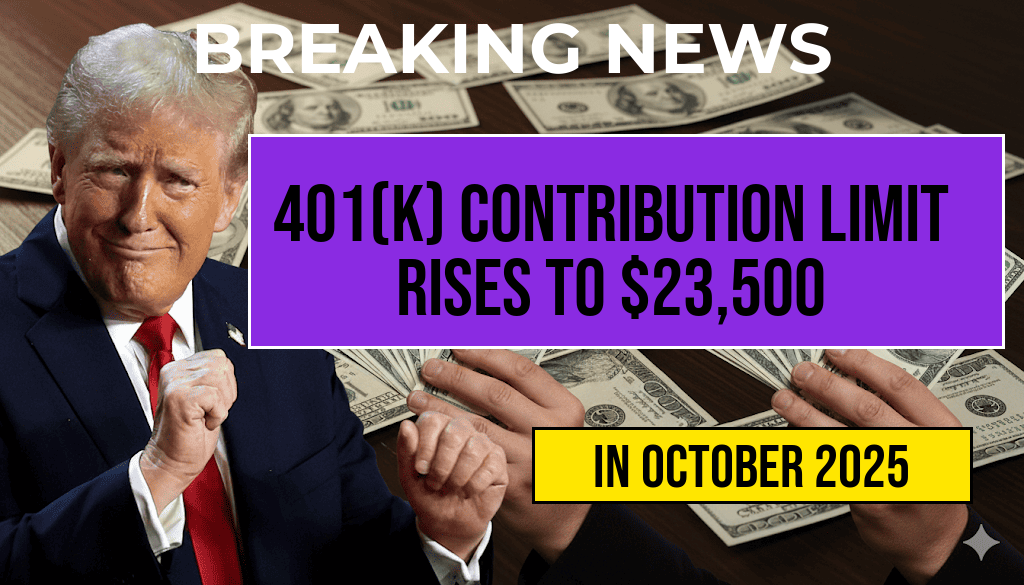The Internal Revenue Service (IRS) has officially announced a significant increase in the contribution limits for 401(k) retirement plans, allowing employees to contribute up to $23,500 in 2025. This marks a notable jump from the previous limit, reflecting a broader effort to enhance retirement savings amidst rising inflation and economic pressures. The increase aims to provide workers with more opportunities to save for their futures and to keep pace with the cost of living. As Americans face a growing need for financial security in retirement, this adjustment could play a crucial role in helping them reach their savings goals.
Details of the Contribution Increase
The IRS adjusts 401(k) contribution limits periodically to account for inflation and to encourage higher savings rates among employees. For 2025, the increase from $22,500 to $23,500 represents a 4.4% rise, a substantial change that could benefit millions of American workers. This adjustment is especially relevant for younger employees and those nearing retirement age who want to maximize their contributions.
Annual Contribution Limits
Here’s a breakdown of the contribution limits over the past few years:
| Year | Contribution Limit |
|---|---|
| 2021 | $19,500 |
| 2022 | $20,500 |
| 2023 | $22,500 |
| 2024 | $22,500 |
| 2025 | $23,500 |
Impact on Retirement Savings
Financial experts emphasize the importance of maximizing retirement contributions, as it can significantly impact long-term savings growth. Contributing the maximum amount allows employees to take full advantage of compounded interest, which can lead to substantial savings by retirement age. For instance, individuals who consistently contribute the maximum amount over several decades could see their retirement funds grow exponentially.
Considerations for Employers
Employers also play a vital role in facilitating employee savings. Many companies offer matching contributions, which can effectively increase employees’ retirement savings without additional out-of-pocket costs for the workers. As the contribution limit rises, employers may need to reassess their matching policies to remain competitive and encourage employee participation in retirement savings plans.
- Employers should evaluate their current matching contributions.
- Offer educational resources about retirement planning.
- Promote the benefits of maximizing 401(k) contributions.
Broader Economic Context
The increase in 401(k) contribution limits comes against a backdrop of ongoing economic challenges, including inflation and market volatility. As prices for essential goods and services continue to rise, many Americans are finding it increasingly difficult to save adequately for retirement. This new limit could provide a much-needed incentive for employees to set aside more funds and take control of their financial futures.
Advice for Employees
Employees are encouraged to review their current contribution levels and consider adjusting them to take advantage of the new limits. Financial advisors recommend the following strategies:
- Automate contributions: Setting up automatic increases can help ensure that employees don’t miss out on the new limits.
- Diversify investments: Consider a mix of investment options within the 401(k) to balance risk and growth potential.
- Consult a financial advisor: Professional guidance can provide personalized strategies to maximize retirement savings.
As the IRS continues to adjust contribution limits, staying informed about changes is crucial for employees aiming to secure their financial futures. For more detailed information on retirement savings and to stay updated, visit the IRS retirement plans page or check out resources from Forbes.
Frequently Asked Questions
What is the new contribution limit for 401(k) plans in 2025?
In 2025, employees can contribute up to $23,500 to their 401(k) plans, marking a significant increase from previous years.
How does the 2025 contribution limit compare to previous years?
The $23,500 limit for 2025 shows a notable increase, reflecting adjustments for inflation and encouraging more savings for retirement compared to earlier limits.
Who is eligible to contribute the maximum amount to their 401(k) in 2025?
Any employee participating in a 401(k) plan can contribute up to the $23,500 limit, provided they meet their employer’s specific eligibility criteria.
Can employees over the age of 50 make additional contributions to their 401(k) in 2025?
Yes, employees aged 50 and older may be eligible to make catch-up contributions beyond the $23,500 limit, allowing them to save even more for retirement.
What impact does the new contribution limit have on retirement savings?
The increased 401(k) contribution limit of $23,500 allows employees to boost their retirement savings significantly, promoting financial security in their later years.

Leave a Reply